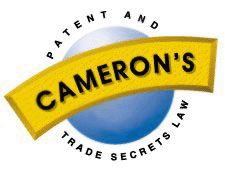
Patent Agents
copyright 1997, 1998 Donald M. Cameron,
Aird & BerlisCameron's Canadian Patent & Trade Secrets Law: Home Page; Index
 |
Patent Agents
|
Table of Contents |
|
| General | Authorized Correspondent |
Communications with the Patent Office are addressed to the Commissioner of Patents [Patent Rules 5(1)] and, for the purpose of prosecuting or maintaining an application, are communicated to and received from, the authorized correspondent [Patent Rule 6(1)].
A patent application is usually prosecuted by a registered Patent Agent.
Any act by a Patent Agent has the same effect as an act by the Applicant [Patent Rules, s. 22].
The only exception is where the inventor owns the invention, in which case, he or she can prosecute the application by him or herself.
Where the Applicant is not an Inventor, the Applicant must appoint a Patent Agent to prosecute the application [Patent Rules, s. 20(1)]
The Patent Agent is appointed either in the Petition or by seperate Notice signed by the Applicant [Patent Rules, s. 20(2)]. Ironically, a Patent Agent can be self-appointing where the appointment is made in a Petition [Patent Rules, s. 6(2) & 20(2)]. The Commissioner shall require an Applicant who is not the Inventor to execute and file an Appointment of a Patent Agent or an Associate Patent Agent within three months of issuing a Notice that the appointment be made [Patent Rules, s. 23].
Any revocation or appointment of another Patent Agent may be done by the Applicant or the existing Patent Agent [Patent Rules, s. 6(2) & 20(3)].
The Authorized Correspondent is usually the Patent Agent [Patent Rules, s. 2(c)] but in some cases can be one or more of the Inventors [Patent Rules, s. 2(a)].
If the application was filed by the Inventor, and the transfer of the rights to the invention has not been registered in the Patent Office, and no Patent Agent has been appointed, the sole inventor, or one or more of the inventors authorized by all inventors to act on their behalf can be the Authorized Correspondent. In the case of a national phase PCT application, where there are two or more Applicants, and where no Inventor has been authorized, the first named Inventor in the International Application becomes the "authorized correspondent".
The Authorized Correspondent can be the Associate Agent where one has been appointed or has to be appointed [Patent Rules, s. 2, 21].
If the Patent Agent prosecuting the application does not reside in Canada, the Patent Agent must appoint an Associate Agent who resides in Canada [Patent Rules, s. 21(1)].
The Applicant's Patent Agent, if residing in Canada, can appoint an Associate Patent Agent who may prosecute the application [Patent Rules, s. 21(2)].
Any act by an Associate Patent Agent has the same effect as an act by the Applicant [Patent Rules, s. 22].
The Associate Patent Agent is appointed either in the Petition or in a Notice signed by the Patent Agent who appointed the Associate Patent Agent [Patent Rules, s. 21(3)].
The appointment of the Associate Patent Agent may be revoked by a Notice signed by the Associate Patent Agent or by the Patent Agent who appointed the Associate Patent Agent [Patent Rules, s. 21(4)].
An Applicant who does not reside in Canada or carry on business at a specified address in Canada, must nominate a Representative residing or carrying on business at a specified address in Canada [Patent Act s. 29(2)]. The Representative is the representative for all purposes under the Patent Act including: the service of any proceedings, of the Applicant and of any foreign patentee [Patent Act s. 29(1)]. For example, if someone wants to impeach an issued patent, they can serve the patentee by service of the originating documents on the Representative.
The Applicant or patentee can appoint a new representative by providing a letter to the Commissioner of Patents [Patent Act s. 29(3)].
Return to:
Cameron's Canadian Patent & Trade Secrets Law: Home Page; Index
Cameron's IT Law: Home Page; Index